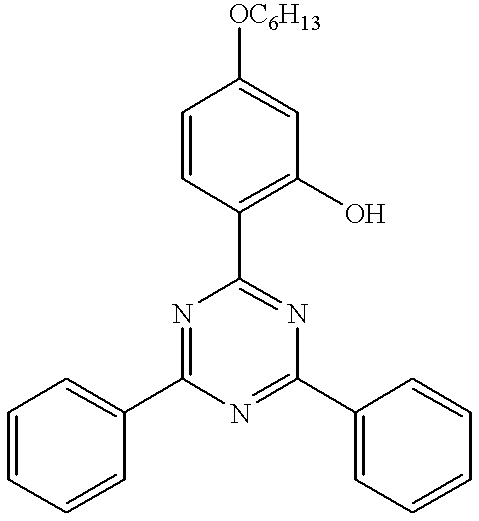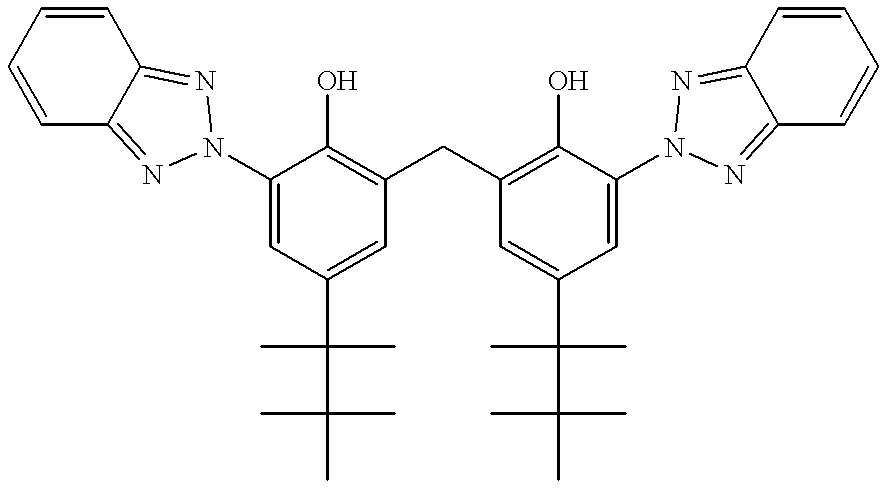White, biaxially oriented, flame-retardant and UV-resistant polyester film with cycloolefin copolymer, its use and process for its production
a polyester film, biaxial orientation technology, applied in the direction of group 5/15 element organic compounds, applications, etc., can solve the problems of uneconomic process, unreusability, regrinding during film production, etc., to achieve excellent suitability for packing foods, processing performance and winding performance of the film, and good thickness profile
- Summary
- Abstract
- Description
- Claims
- Application Information
AI Technical Summary
Benefits of technology
Problems solved by technology
Method used
Image
Examples
example 1
[0142]Chips of polyethylene terephthalate (prepared by the transesterification process using Mn as transesterification catalyst, Mn concentration: 100 ppm) were dried at 150° C. to a residual moisture below 100 ppm and fed to the extruder for the base layer B. Alongside this, chips of ®Topas 6015 cycloolefin copolymer (COC) from Ticona (COC composed of 2-norbornene and ethylene, see also W. Hatke: Folien aus COC [COC Films], Kunststoffe 87 (1997) 1, pp. 58-62) with a glass transition temperature Tg of about 160° C. were also fed to the extruder for the base layer B. The proportional amount of the cycloolefin copolymer (COC) in the entire film was 10% by weight. 1.0% by weight of the UV stabilizer 2-(4,6-diphenyl-1,3,5-triazin-2-yl)-5-hexyloxyphenol (®Tinuvin 1577 from Ciba-Geigy, Basle, Switzerland) and 4% by weight of phosphorus-containing flame retardant were also added.
[0143]Tinuvin 1577 has a melting point of 149° C. and is thermally stable up to about 330° C. The UV stabilizer ...
example 2 (
INVENTIVE)
[0152]A change was made from Example 1 by adding 50% by weight of regrind to the base layer. The amount of COC in the film thus produced was again 10% by weight, the amount of UV stabilizer was 1% by weight, and the amount of flame retardant was 4% by weight. The process parameters were unchanged from Example 1. A visual observation was made of any yellow coloration of the film. It can be seen from Table 2 that hardly any yellow coloration of the film could be observed.
[0153]Base layer B was a mixture of:
[0154]
42.5% by weight ofpolyethylene terephthalate homopolymer with anSV of 80050.0% by weight ofregrind (90% by weight of polyester + 10% byweight of Topas 6015 + 1% by weight of Tinuvin1577) 5.0% by weight ofcycloolefin copolymer (COC) from Ticona, Topas6015 0.5% by weight ofTinuvin 1577 2.0% by weight ofAmgard P 1045
example 3 (
INVENTIVE)
[0155]Example 1 was now modified by producing a film of thickness 96 μm. The amount of COC in the film was 8% by weight, the amount of Tinuvin 1577 was 1% by weight, and the amount of flame retardant was 4% by weight. The process parameters were unchanged from Example 1. A visual observation was made of any yellow coloration of the film. It can be seen from Table 2 that no yellow coloration of the film was observed.
[0156]Base layer B was a mixture of:
[0157]
87.0% by weight ofpolyethylene terephthalate homopolymer with anSV of 800 8.0% by weight ofcycloolefin copolymer (COC) from Ticona, Topas6015 1.0% by weight ofTinuvin 1577 4.0% by weight ofAmgard P 1045
PUM
| Property | Measurement | Unit |
|---|---|---|
| glass transition temperature | aaaaa | aaaaa |
| glass transition temperature | aaaaa | aaaaa |
| density | aaaaa | aaaaa |
Abstract
Description
Claims
Application Information
 Login to View More
Login to View More - R&D
- Intellectual Property
- Life Sciences
- Materials
- Tech Scout
- Unparalleled Data Quality
- Higher Quality Content
- 60% Fewer Hallucinations
Browse by: Latest US Patents, China's latest patents, Technical Efficacy Thesaurus, Application Domain, Technology Topic, Popular Technical Reports.
© 2025 PatSnap. All rights reserved.Legal|Privacy policy|Modern Slavery Act Transparency Statement|Sitemap|About US| Contact US: help@patsnap.com



